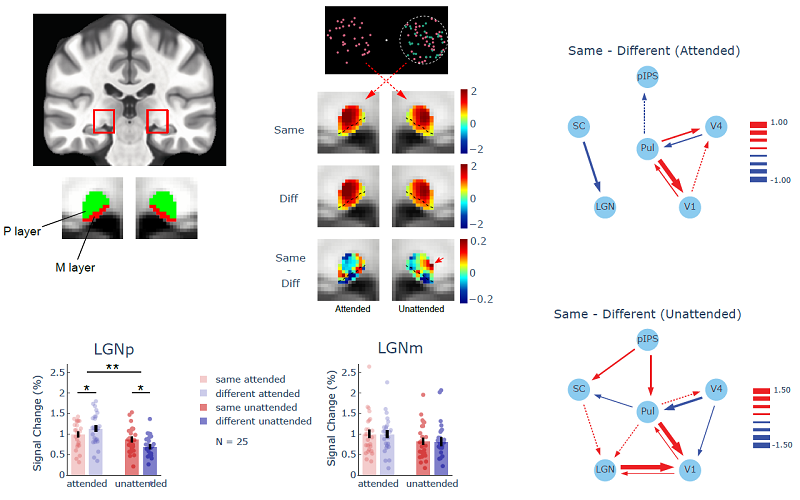7-Tesla fMRI Reveals Subcortical Mechanisms of Feature-Based Attention
In everyday life, humans can rapidly locate target information based on simple features such as color or shape. Although previous studies have confirmed the spatially global effects of such feature-based attention at the cortical level, its subcortical neural mechanisms have remained unclear.
A research team led by Prof. ZHANG Peng from the Institute of Biophysics of the Chinese Academy of Sciences, for the first time, used high-resolution 7-Tesla functional magnetic resonance imaging (7T fMRI) to reveal the critical role of human subcortical nuclei in spatially global feature-based attention.
The study was recently published in Communications Biology On October 15, 2025.
Based on the color-encoding properties of neurons in the parvocellular layers of the lateral geniculate nucleus (LGN), the researchers designed a red-green (L-M) contrast visual paradigm.
High-resolution 7T fMRI results showed that when a stimulus outside the spatial focus of attention (unattended side) shared the same color as the attended target, the color response in the LGN parvocellular layers-and the feedforward and feedback connectivity between the LGN and primary visual cortex (V1)-were significantly enhanced.
These findings indicate that the LGN serves as an early gating site for cross-field, global feature-based attention.
Further analyses revealed that the deeper layers of the superior colliculus (SC) participated in the control of global feature-based attention, while the ventrolateral subdivision of the pulvinar nucleus coordinated the transmission of attentional information between cortical regions.
Interestingly and unexpectedly, the enhanced activity in the visual thalamus for the unattended stimulus was accompanied by reduced responses to the attended stimulus, an effect not observed in cortical areas. This supports the existence of a thalamus-mediated, spatially global attentional sampling mechanism.
This study, for the first time, uncovers the key roles of subcortical nuclei in global feature-based attention, providing important evidence toward an integrated theoretical framework of attention that encompasses both cortical and subcortical mechanisms.

Figure: Layer-specific modulation and functional connectivity of global feature-based attention in the thalamic lateral geniculate nucleus (LGN)
(Image by ZHANG Peng's group)
Article link: https://www.nature.com/articles/s42003-025-08871-6
Contact: ZHANG Peng
Institute of Biophysics, Chinese Academy of Sciences
Beijing 100101, China
E-mail: zhangpeng@ibp.ac.cn
(Reported by Prof. ZHANG Peng's group)

